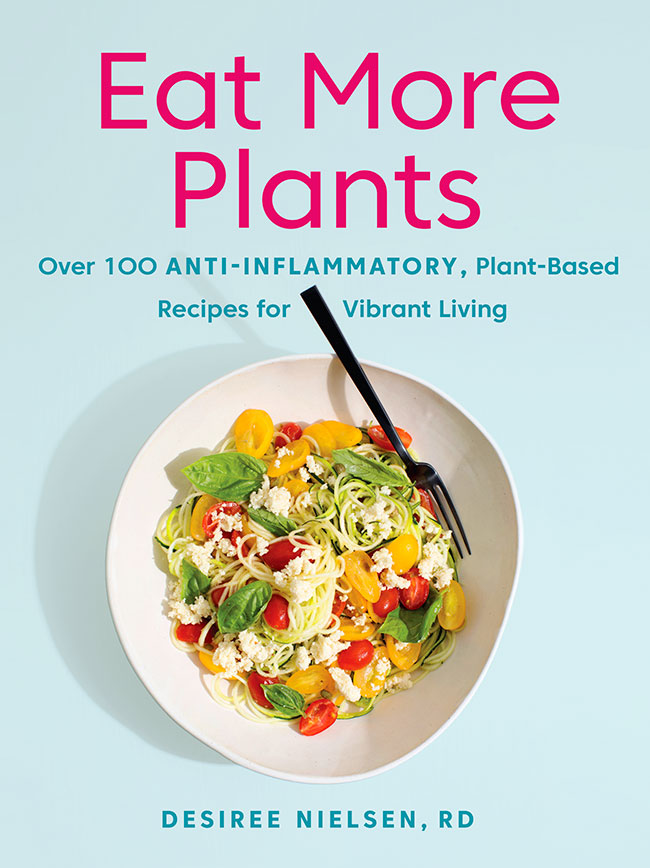How to Eat Better at Home, Plus a Superfood Breakfast Recipe

Desiree Nielsen's blushing beet smoothie harnesses the anti-inflammatory benefits of the beet with a sweet-tart flavour that's perfect for breakfast. Photo: Eat More Plants
Eating better at home isn’t always easy, especially when you’re there all day, all the time. But it’s important to be mindful of what we eat and how we shop for food, no matter what the circumstances.
“Inflammation is supposed to protect us from infection or injury; however, the less we sleep, the more stressed we are, and the less we nourish our bodies with whole foods, the more our lifestyle becomes the source of injury,” says Desiree Neilsen, a Vancouver-based registered dietitian, author of the plant-based cookbook Eat More Plants and host of The Urban Vegetarian.
“Eating more plant foods is a powerful step in fighting chronic inflammation as plants contain plenty of fibre and anti-inflammatory phytochemicals that help foster a healthy gut microbiota and support a balanced inflammatory response.” And, perhaps more importantly, it will help us curb bad eating habits. “Eating more plants will help us move away from the high-sugar, high-saturated fat, low-fibre eating pattern that is associated with chronic inflammation and disease,” she says.

How to eat well when you’re home more often
When you’re at home all the time, it is quite tempting to abandon routine (no breakfast! toast for dinner!) but maintaining structure in your eating habits will help you stay well nourished. Set regular meal times. Ensure that you always have some source of protein like fish or tofu and some fruits or vegetables at each meal. If you aren’t inspired to do a lot of cooking, follow the ‘cook once, eat twice’ rule: every time you cook, make a double batch. Whether it’s a one pot meal like chili that can be frozen, or grilled vegetables and proteins that can be repurposed for wraps or salads throughout the week, it will make eating well far easier.
Use Plant-Based Ingredients
Plant-based protein such as beans, nuts and seeds are economical and can help you stay healthy and energized. If you’ve been curious about eating more plants, start with simple plant-based swaps for the foods you consume everyday. Swirl a creamy soy beverage, such as Silk Unsweetened Soy, into your oats instead of milk. Soy beverages offer plenty of bone-saving calcium along with plant-based protein.
How to Plan Your Grocery Store Shop
To minimize trips to the grocery store, focus on versatile foods with a long shelf life, such as canned beans and tomatoes, whole grains like millet or barley and long storage produce such as carrots, onions, apples and oranges. These foods can be put together in a myriad of ways, from soups and stews to pilafs and casseroles. The secret to making pantry staples more exciting is to have fun with different spices and condiments. Ensure your fridge is stocked with plenty of flavour options, from fresh lemons and garlic to soy sauce and pesto. Keep a few extra dried spices on hand too. Cumin adds an earthy depth to black beans and rice or curries. Oregano is delicious with roasted potatoes or in tomato sauces. And cardamom is a delicious twist for Scandinavian-inspired baking.
Blushing Beet Smoothie Bowl
DAIRY-FREE | GLUTEN-FREE | PALEO-FRIENDLY | VEGAN | VEGETARIAN
SERVES 2
Acai bowls are great, but berries that need to be flown across the globe are not the most eco-friendly choice when we have beets – an awesome homegrown superfood. I love beets because their intense jewel hue belies a bounty of anti-inflammatory benefits. They contain pigments called betalains, which help to fight inflammation, and if you tend to get a little hot under the collar, beets also help to lower blood pressure. The raspberries balance out the earthiness of the beets for a sweet-tart treat that will brighten your morning.
1½ cups (375 mL) frozen raspberries
½ cup (125 mL) peeled roughly chopped cooked red beets
½ frozen ripe banana, roughly chopped
(about a 3-inch/8 cm piece)
1 tablespoon (15 mL) ground flaxseed
1 lemon slice (¼ inch/5 mm thick), skin on
½ cup (125 mL) unsweetened almond milk or soy milk
1 scoop vanilla protein (optional)
Toppings (optional) Slivered raw almonds Chia seeds
Unsweetened coconut flakes Unsweetened granola Pomegranate seeds
Lychee
- In a high-speed blender, combine the raspberries, beets, banana, flaxseed, lemon, almond milk, and vanilla protein (if using). Blend until smooth. The mixture should be thick.
- Pour into chilled bowls, add desired toppings, and serve immediately.
Tip: Smoothie bowls are really just smoothies, heavy on the frozen fruit and light on the liquid. Cooking for one? Pour the remaining smoothie mixture into a freezer-safe container and store in the freezer for the next day. Remove from the freezer as soon as you wake up and it will be ready to eat in about 20 minutes.
Excerpted from Eat More Plants by Desiree Nielsen. Copyright © 2019 by Desiree Nielsen. Published by Penguin, an imprint of Penguin Canada, a division of Penguin Random House Canada Limited. Reproduced by arrangement with the Publisher. All rights reserved.
A version of this story was originally published on May 7, 2020.
RELATED: